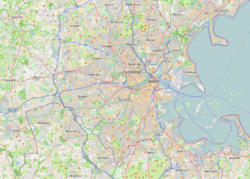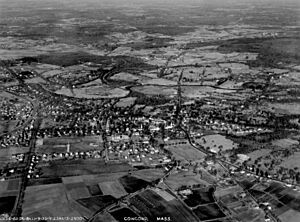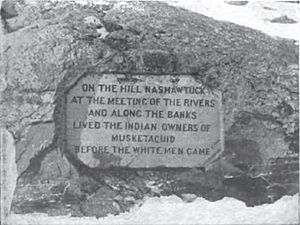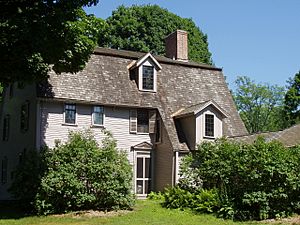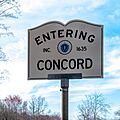Concord, Massachusetts facts for kids
Quick facts for kids
Concord, Massachusetts
|
||
|---|---|---|
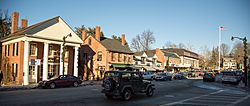
View of Concord's Main Street, looking east toward Monument Square
|
||
|
||
| Motto(s):
Quam Firma Res Concordia (Latin)
"How Strong Is Harmony" |
||
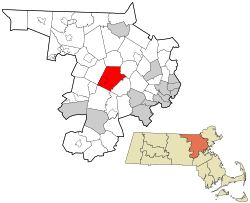
Location in Middlesex County, Massachusetts
|
||
| Country | ||
| State | ||
| County | Middlesex County | |
| Settled | 1635 | |
| Incorporated | September 12, 1635 | |
| Founded by | Peter Bulkley and Simon Willard | |
| Government | ||
| • Type | Open town meeting | |
| Area | ||
| • Total | 67.4 km2 (25.9 sq mi) | |
| • Land | 64.5 km2 (24.9 sq mi) | |
| • Water | 2.5 km2 (1.0 sq mi) | |
| Elevation | 43 m (141 ft) | |
| Population
(2020)
|
||
| • Total | 18,491 | |
| • Density | 274.35/km2 (713.9/sq mi) | |
| Time zone | UTC−5 (Eastern) | |
| • Summer (DST) | UTC−4 (Eastern) | |
| ZIP Code |
01742
|
|
| Area code(s) | 351 / 978 | |
| FIPS code | 25-15060 | |
| GNIS feature ID | 0619398 | |
| Website | www.concordma.gov | |
Concord (pronounced like "conquered") is a historic town in Middlesex County, Massachusetts, United States. In 2020, about 18,491 people lived there. It's considered part of the larger Greater Boston area. The town center is located where the Sudbury and Assabet rivers meet to form the Concord River.
The area was originally called Musketaquid by the Algonquian people. This word means "grassy plain." English settlers founded Concord in 1635. By 1775, it had grown to about 1,400 people. Concord became famous on April 19, 1775, when the first battles of the American Revolutionary War took place here. These battles, known as the battles of Lexington and Concord, included the famous "shot heard round the world."
In the mid-1800s, Concord became a hub for famous writers. This group included Ralph Waldo Emerson, Nathaniel Hawthorne, Louisa May Alcott, and Henry David Thoreau. Many important books were written here, such as Alcott's Little Women, Emerson's Self-Reliance, and Thoreau's Walden and Civil Disobedience. Also, the well-known Concord grape was first grown in Concord by Ephraim Wales Bull.
Today, Concord is a wealthy suburb of Boston and a popular place for tourists. Visitors come to see historical sites like the Old North Bridge, Orchard House, and Walden Pond. The town still has a strong connection to literature. It is also known for being environmentally friendly. In 2012, it was the first town in the U.S. to ban the sale of small plastic water bottles.
Contents
History of Concord
How Concord Was Founded
The area that became Concord was first known as "Musketaquid." This name came from the Algonquian people and meant "grassy plain." It was a good place to live because the Sudbury and Assabet rivers met there. The land had many low-lying marshes and was great for farming. Native Americans grew corn and found plenty of fish in the rivers.
In 1635, a group of English settlers arrived. Their leaders were Rev. Peter Bulkley and Major Simon Willard. They received permission from the General Court to buy land from the local Native American tribes. Simon Willard was a good trader and spoke the Algonquian language. He had earned the trust of the Native Americans. The settlers traded items like wampum, hatchets, knives, and cloth for about 6 square miles (15.5 km²) of land. This peaceful purchase led to the new town being named "Concord," which means agreement or harmony.
The Start of the American Revolution
The battles of Lexington and Concord were the very first military fights of the American Revolutionary War. This war led to the United States becoming an independent country.
On April 19, 1775, about 700 British soldiers marched from Boston to Concord. They wanted to take away weapons that the American colonists had stored in the town. But the Patriot leaders had already moved most of the weapons. About 150 Patriot minutemen (local soldiers ready to fight at a minute's notice) had been warned that the British were coming. They met the British in Lexington.
A fight broke out, and it's still not known who fired the first shot. The British fired at the Americans, killing eight, and then used bayonets to make them scatter. The British then continued to Concord and split up to search for the weapons. Later that morning, around 11:00 AM, 400 minutemen fought 100 British soldiers at the Old North Bridge. Both sides had casualties, and the British had to retreat.
After searching Concord, the British marched back to Boston. But minutemen kept attacking them in small, quick fights. The British suffered more losses before reaching Charlestown, Boston. The minutemen then blocked the land routes to Charlestown, starting the siege of Boston. The poet Ralph Waldo Emerson later wrote about the shot fired at the Old North Bridge in his 1837 poem "Concord Hymn." He called it the "shot heard round the world."
In 1894, the day of the battle, April 19, was named Patriots' Day. In April 1975, Concord held a big celebration for the 200th anniversary of the battle. President Gerald Ford gave a speech at the Old North Bridge.
Concord's Famous Writers
Concord has a very rich history of famous writers, especially in the 1800s. Ralph Waldo Emerson (1803–1882) moved to Concord in 1835 and became its most well-known citizen. He was a successful speaker and thinker. Emerson's family had deep roots in the town. His grandfather had even seen the battle at the North Bridge from his house.
Emerson was the leader of a group of thinkers called Transcendentalists who lived in Concord. This group included the writer Nathaniel Hawthorne (1804–1864) and the philosopher Amos Bronson Alcott (1799–1888), who was the father of Louisa May Alcott (1832–1888). Henry David Thoreau (1817–1862), who was born in Concord, was another important member of Emerson's group. Because so many talented writers lived in one small town, Henry James called Concord "the biggest little place in America."
Many important books came from this creative environment. These include Emerson's essays like Self-Reliance (1841) and Louisa May Alcott's novel Little Women (1868). Hawthorne wrote his story collection Mosses from an Old Manse (1846) here. Thoreau famously lived in a small cabin near Walden Pond. There, he wrote Walden (1854), which describes his simple life in nature.
Thoreau was also put in the Concord jail for refusing to pay taxes. He did this to protest slavery and the Mexican–American War. After this, he wrote the important essay "Resistance to Civil Government," now known as Civil Disobedience (1849). Thoreau and many of his neighbors also helped enslaved people escape to freedom through the Underground Railroad.
The Wayside, a house on Lexington Road, has been home to several authors. The Alcott family lived there, calling it "Hillside." They later sold it to Hawthorne in 1852. The Alcotts then moved to the nearby Orchard House in 1858. Hawthorne named the house "The Wayside" and lived there until he died. Today, both The Wayside and the Orchard House are museums. Emerson, Thoreau, Hawthorne, and the Alcotts are all buried in Authors' Ridge in Concord's Sleepy Hollow Cemetery.
Concord still has a lively literary culture today. Famous authors who have lived there recently include Doris Kearns Goodwin, Alan Lightman, and Gregory Maguire.
The Concord Grape
In 1849, Ephraim Wales Bull created the well-known Concord grape at his home in Concord. The original vine still grows there today. Welch's, the first company to sell grape juice, has its main office in Concord.
Bull developed the Concord grape by trying out seeds from native grape plants. He planted about 22,000 seedlings on his farm before he found the perfect grape. The Concord grape ripens early, which helps it avoid frost in northern areas. It also has a rich, full flavor and is very strong, unlike European grapes that often failed to grow here.
In 1853, Bull showed his first Concord grapes to the public. He won a prize at the Boston Horticultural Society Exhibition. From these first grapes, the fame of Bull's Concord grape spread around the world. He was known as "the father of the Concord grape." Even though he sold cuttings for a lot of money, he died a relatively poor man. His tombstone says, "He sowed—others reaped."
Plastic Bottle Ban
On September 5, 2012, Concord became the first community in the United States to ban the sale of water in small plastic bottles. The law stopped the sale of PET bottles of 1 liter (33.8 U.S. fl oz) or less starting January 1, 2013.
This ban caused a lot of discussion across the country. Some people thought the ban was not fair because other bottled drinks like soda were still allowed. Others believed it wouldn't really stop people from buying bottled water, as it was still available nearby.
However, attempts to cancel the ban have failed in town meetings. In April 2013, a vote to repeal the ban was strongly defeated. Jean Hill, an 86-year-old resident who led the fight for the ban, said she felt she had "really accomplished something." The vote was so clear that an official count wasn't even needed. Most of the 1,127 voters were against repealing the ban.
Geography of Concord
Concord covers a total area of about 25.9 square miles (67.1 km²). Most of this is land (24.9 sq mi or 64.5 km²), and about 1.0 sq mi (2.6 km²) is water.
The city of Lowell is about 13 miles (21 km) north of Concord. Boston is 19 miles (31 km) to the east. The town center is where the Sudbury and Assabet rivers meet to form the Concord River. This river then flows north to the Merrimack River in Lowell. From 1835 to 1940, gunpowder was made in the American Powder Mills complex along the Assabet River.
People in Concord
Concord has grown over the years. In 1850, there were 2,249 people. By 2020, the population had reached 18,491.
In 2020, there were 7,295 homes in Concord. About 36% of families had children under 18 living with them. Most households (about 63%) were married couples. The average family size was 3.18 people.
About 25% of the population was under 18 years old. The median age in Concord was 42 years. This means half the people were younger than 42 and half were older.
The average household income in Concord was $184,086 in 2020. Only about 2.5% of the population lived below the poverty line.
Things to See and Do in Concord
- Barrett's Farm: A historic farm.
- Concord Museum: Learn about the town's history.
- Concord's Colonial Inn: A historic inn.
- Egg Rock: Where the Sudbury and Assabet rivers meet to form the Concord River.
- Ralph Waldo Emerson House: The home of the famous writer.
- Great Meadows National Wildlife Refuge: A place to see nature and wildlife.
- Minute Man National Historical Park: Includes the famous The Minute Man statue.
- The Old Manse: A historic home where Emerson and Hawthorne lived.
- Old North Bridge: The site of a key battle in the American Revolution.
- Orchard House: The home of Louisa May Alcott, where she wrote Little Women.
- Sleepy Hollow Cemetery: Where many famous authors are buried.
- Walden Pond: The pond where Henry David Thoreau lived in a cabin.
- The Wayside: Another historic home where Louisa May Alcott, Nathaniel Hawthorne, and Margaret Sidney lived.
- Wheeler-Minot Farmhouse: Also known as Thoreau Farm, the birthplace of Henry David Thoreau.
Education in Concord
Concord has several schools for students of different ages:
- Concord-Carlisle Regional High School: The public high school for the area.
- Concord Middle School: Has two buildings, Sanborn and Peabody.
- Alcott School, Willard School, and Thoreau School: The public elementary schools.
- Concord Academy and Middlesex School: Private high schools.
- The Fenn School: A private school for boys in grades 4-9.
- The Nashoba Brooks School: A private school for boys and girls in pre-kindergarten to grade 3, and for girls in grades 4-8.
Sister Cities
Concord has special connections with two other cities around the world:
- Nanae, Japan
- Saint-Mandé, France
Images for kids
-
The Wayside, home in turn to Louisa May Alcott, Nathaniel Hawthorne, and Margaret Sidney
See also
 In Spanish: Concord (Massachusetts) para niños
In Spanish: Concord (Massachusetts) para niños



